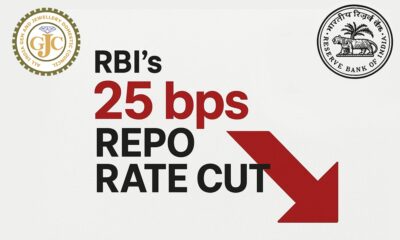International News
WGC REPORT: Is the threat of US tariffs moving the gold market?

Key highlights
• The gold market has seen a significant rise in COMEX gold inventories, along with a widening of the spread between futures and spot prices, sparked by tariff uncertainty
• This, combined with reports of falling inventories in London, has fuelled speculation about stability in the gold market
• Events like these have happened before and the market has normalised • As such, we believe that the disruptions will likely ease…although the current environment of elevated geoeconomic risks could result in intermittent spikes
• Most importantly, despite all the noise, the gold spot market has remained well behaved – and has generally benefited from flight-to-quality flows.
Gold bullion flows West amidst tariff uncertainty
In late 2024 COMEX inventories started to rise as concerns grew that tariffs could impact gold imports.1 This surge of gold imports into the US caught many gold market observers by surprise, as the country is (more or less) self-sufficient in its gold needs, being both a significant producer and a consumer.2 While gold itself hasn’t been directly targeted, speculation and shifting risk management strategies amid concerns of broad-based tariffs have still had a noticeable impact on prices and trading patterns. This trend has continued into early 2025 and, as of date, COMEX registered and eligible inventories have increased by nearly 300t (9mn oz) and more than 500t (17mn oz), respectively (Chart 1).
By way of context, short-term speculators and some investors often hold large net-long gold futures positions on the COMEX futures market, while banks and other financial institutions short these futures contracts as counterparties. But these financial institutions are generally not short gold; instead, they run long over-the-counter (OTC) positions to hedge their futures shorts. And because physical gold is more often found in the London OTC market – as a large trading hub and often a cheaper location in which to vault gold – financial institutions typically prefer to hold these hedges in London, knowing that they can quickly – in normal market times – ship gold to the US when there is a need. In recent months, many traders have chosen to pre-empt the threat of tariffs by moving gold to the US, thus avoiding the possibility that they may have to pay higher charges.
Alongside the increase in inventories, the price of COMEX gold futures contracts – and their spread to spot gold traded in London – also rose, with traders factoring in potential tariff-related costs. For example, the spread between the COMEX active gold futures contract and gold spot reached as much as US$40/oz to US$50/oz (140-180 bps), significantly above the US$13/oz (60 bps) average from the past two years.3
Now…this is not new. COMEX inventories – and the differential between futures and spot prices – have risen before, most notably at the onset of the COVID pandemic.
The main question from investors, amidst reports of falling inventories, is: can gold’s largest OTC trading hub, London, cope with the market disruption? We can look at past examples for guidance and analyse all the currently available data to offer an informed opinion – considering, of course, the heightened level of uncertainty all financial markets are experiencing in the current environment.
London inventories have fallen…but not as much as some think
As COMEX inventories rose during COVID, London inventories fell. And both eventually normalised. At present, total LBMA reported inventories stand at approx. 8,500t (Chart 2), out of which approx. 5,200t are held at the Bank of England (BoE). And while there are reports of queues to retrieve gold, it is important to note that BoE operates differently from commercial vaults – longer wait times create a perception of scarcity that is more likely explained by logistics instead.4
Another consequence has been an increase in gold’s lending rate. A calculation based on overnight borrowing rates and gold swap rates, as a proxy, suggests that one-month lease rates reached as high as 5% during January, reflecting ‘tightness’ in the London gold market (Chart 3).
Gold’s diverse sources of supply can promote normalisation
Trade data from the Census Bureau suggests that a good portion of gold flowing into the US comes from Switzerland. In turn, some of this gold could have originated in the UK as it needs to be refined from Good Delivery (~400 oz) bars into 1 kg bars – the weight accepted for delivery into COMEX futures.5 Other sources of gold include Canada, Latin America, Australia and, to a lesser degree, Hong Kong. And then there’s gold from domestic mine production – the US being the fifth largest producer globally – which can be refined locally.
Of course, gold flowing into the US from around the world may limit the amount of gold going into other markets, including London, but we believe that the impact should be temporary. This is especially true as gold has multiple sources of supply – mine production and recycling – spread around the world, reducing the reliance on imported gold to meet local demand in the medium term.
A few signs of normality are starting to emerge: the buildup of COMEX inventories has slowed; the spread differential between gold futures and spot prices is falling,6 and the bid-ask spread for gold ETFs – many of which vault their gold in London – remain well behaved.7 In addition, the lease rates also seems to be cooling down, with data suggesting it is now closer to 1% and well below January’s record high (Chart 3).
While part of gold’s strong price performance could be attributed to momentum, our analysis suggests that it has been supported by flight-to-quality flows amid increased financial market volatility driven by geoeconomic and geopolitical concerns.8
In summary
Gold has not been a direct target of tariffs, but market reactions to trade uncertainty has driven a significant shift in trading behaviour and impacted the gold price. The movement of gold from London to the US, rising COMEX premiums and concerns over availability were largely the result of risk management decisions rather than true supply issues.
Now that COMEX inventories appear to be well-stocked and the backlog of withdrawals from the BoE continues to be cleared, these disruptions should ease over the coming weeks. However, this period serves as a stark reminder that even indirect trade policy concerns can send ripples through global financial markets.
This may not be the last time we see temporary distortions in the gold market. The signs are, however, that the depth and liquidity of the gold market is able to absorb – over time – most of these shocks.
International News
Kering Invests in China’s Gold Jewelry Surge as Laopu’s Explosive Growth Reshapes Market
Heritage-gold brands Borland and Lamchiu secure major funding amid soaring demand, fueled by Laopu’s meteoric rise and China’s booming 24-karat segment.

A wave of investor interest is sweeping through China’s gold jewelry sector as the rapid rise of Laopu Gold Co. galvanizes confidence in the country’s high-end heritage gold market. The latest beneficiary is Borland, a Hangzhou-based jeweler known for its traditional filigree craftsmanship, which this week announced more than 100 million yuan ($14 million) in new funding.
The investment round includes contributions from Kering Ventures, the startup arm of luxury group Kering SA, and Shunwei Capital, co-founded by Xiaomi chairman Lei Jun. Kering noted that its minority stake enables participation in the “rapid development of a particularly buoyant 24-karat gold jewelry segment,” reflecting growing appetite for culturally rooted premium gold pieces.
Meanwhile, Dayone Capital has made a separate investment exceeding 100 million yuan in Lamchiu, a Lanzhou-based maker of handcrafted bespoke gold jewelry. The firm will support Lamchiu in expanding distribution and reinforcing the brand’s supply-chain capabilities.
The surge of capital follows the remarkable ascent of Laopu, which has become one of China’s breakout jewelry success stories. The company reported 12.4 billion yuan in revenue in the first half of 2025 — a year-on-year increase of over 250%, building on 168% growth from the previous year. Laopu’s momentum has outpaced Western luxury houses struggling with softer China demand.
Heritage gold jewelry — deeply rooted in Chinese aesthetics and traditional techniques like filigree — is attracting a new generation of luxury consumers. Brands like Laopu, which operate in top-tier malls, increasingly compete with global maisons such as Hermès and Cartier for clientele.
Despite strong digital followings, newer brands still face distribution gaps. Borland operates only three mall stores, while Lamchiu, despite amassing more than 1 million followers on Douyin, runs just one physical outlet in Lanzhou. Both companies plan to use their fresh funding to accelerate expansion and strengthen operational infrastructure.
The latest investments signal rising confidence that China’s heritage-gold renaissance is evolving from a trend into a long-term luxury category shaping the future of the jewellery market.
-

 National News8 hours ago
National News8 hours agoGJC welcomes RBI’s 25 basis point repo rate cut
-

 National News9 hours ago
National News9 hours agoIndia’s World Cup victory celebrated with India’s own gold through Tanishq exchange
-

 ShowBuzz8 hours ago
ShowBuzz8 hours agoT.GOLD: The most innovative technologies for competitive and sustainable jewellery
-

 International News11 hours ago
International News11 hours agoGold edges lower, Silver stages a recovery as markets await crucial U.S. data







